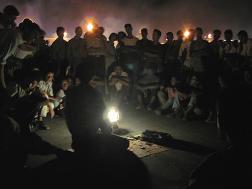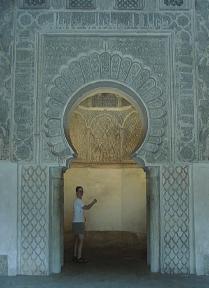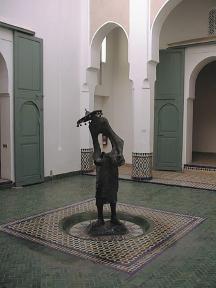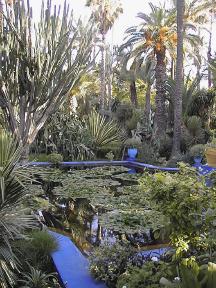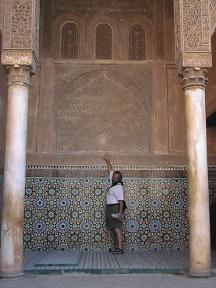Marrakesh
August 13th - August 17th, 1999
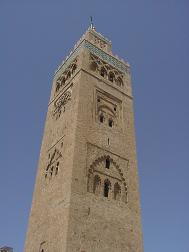 Having had a good,
long break from cultural sight-seeing, we were excited to be back on the
road and off to Marrakesh. Unfortunately, the earliest bus leaving Essaouira
for Marrakesh was at 5PM, rather late to get started. To top it off, August
14th is a national holiday (allegiance of Wadi-Edda-hab, whatever that is),
so we were a bit apprehensive arriving late. We had reason to be; turns
out most of the hotels filled earlier in the afternoon, so when we started
looking for a room at 8PM all the hotels had their "complet" signs
out. Trudging around from hotel to hotel with our packs was no fun at all,
especially for Kathy who had just gotten over being sick. Despite visible
discomfort, she hung tough until we found a hotel that would allow us to
sleep on their terrace. As we stood there contemplating sharing a concrete
roof with about a half dozen other unlucky travelers, fate intervened. The
hotel had been holding a room for a traveler who previously reserved it,
but it was now past their expected time of arrival. The clerk behind the
desk looked at us and asked if we would like that room. Talk about being
in the right place at the right time! We plopped ourselves and our packs
down in our modest but lucky room and swore we would never travel in August
again.
Having had a good,
long break from cultural sight-seeing, we were excited to be back on the
road and off to Marrakesh. Unfortunately, the earliest bus leaving Essaouira
for Marrakesh was at 5PM, rather late to get started. To top it off, August
14th is a national holiday (allegiance of Wadi-Edda-hab, whatever that is),
so we were a bit apprehensive arriving late. We had reason to be; turns
out most of the hotels filled earlier in the afternoon, so when we started
looking for a room at 8PM all the hotels had their "complet" signs
out. Trudging around from hotel to hotel with our packs was no fun at all,
especially for Kathy who had just gotten over being sick. Despite visible
discomfort, she hung tough until we found a hotel that would allow us to
sleep on their terrace. As we stood there contemplating sharing a concrete
roof with about a half dozen other unlucky travelers, fate intervened. The
hotel had been holding a room for a traveler who previously reserved it,
but it was now past their expected time of arrival. The clerk behind the
desk looked at us and asked if we would like that room. Talk about being
in the right place at the right time! We plopped ourselves and our packs
down in our modest but lucky room and swore we would never travel in August
again.
Koutoubia Mosque
This 12th century mosque midway through restoration was built by the
Almohads who once ruled from Spain to Tunisia and made Marrakesh their capitol.
The mosque was built along with two siblings, one in Rabat
and the other in Sevilla.
That sibling mosque is the one razed by the Christians when they recaptured
southern Spain and its minaret was converted into the cathedral's tower.
One of the main mosques in Marrakesh to this day, the crowds swell in the
early evening, and the mosque's chants were quite audible from our hotel
room. Except for the morning that the power failed in Marrakesh. We should
have realized something was up as we were able to sleep quite late that
morning and once we awoke the city was unusually still. And in case you're
wondering, the muezzin or mosque crier, once his amplification equipment
fails no longer climbs the mosque's tower and yells out the call to prayer.
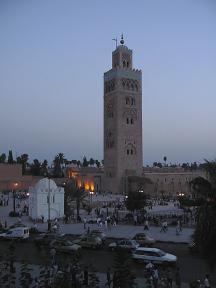
Djemâa el-Fna
Djemâa el-Fna (literally means Assembly of the Dead) got its name
as it once was the square where criminals were publicly executed and their
remains left on display as a lesson to all. Now, the square comes to life
in the evening as a Moroccan-style circus with no tent. Vendors sell all
sorts of food, drinks and desserts on the edges of the square while in the
center anyone who wishes sets up a lamp and begins to entertain whatever
crowd decides to linger. There are fortune tellers, snake charmers, boxing
rings and arcade games. Most of the crowd is Moroccan - locals from surrounding
villages who seemed quite entertained by it all. For our tastes, there really
wasn't much action. Most attractions had more talking than anything else,
and as our Moroccan is a little weak much of it's charm was lost on us.
However, we really did like the square's dentists, one of which shows how
he goes about pulling a bad tooth in the bottom photo.

Madrassa of Ben Youssef
As in Fes, Marrakesh has a very large Koranic school that infidels like
us can wander around in. Unlike Fes, the Madrassa of Ben Youssef is no longer
open, having closed in 1956. This was a very large school, with somewhere
between 400 and 800 students stacked like cordwood in the madrassa's very
modest rooms (photo bottom right). Under restoration now, it's a good chance
to see the kind of architecture used in Mosques and after which much modern
architecture is patterned. Especially pretty is the center worship area
which faces Mecca (photo bottom left).
Moroccan Museum of Art
Near the Madrassa of Ben Youssef is Moroccan Museum of Art. Housed in
an old palace, we found the building to be the main show with its intricately
carved wood, dazzling tiles and beautiful detailing. Most of the displays
are 20th century Moroccan paintings (which we were not allowed to photograph),
but there was a room full of old Moroccan coins: the bottom left photo show
the oldest of them, with one dating from 830 AD. We also were able to photograph
a modern bronze of a stylized Moroccan water seller (bottom right).
Majorelle Gardens
Marrakesh is an oasis in the desert, and over the years many have built
gardens to celebrate the break from the arid wasteland around them. Perhaps
the prettiest is the Majorelle Gardens. Designed by French painter Jacques
Majorelle and currently owned by Yves Saint Laurent, they offer a respite
from the grimy city. The gardens today really are a diamond in the rough,
as they are surrounded by garbage dumps and parking lots.
Saadien Tombs
The finest royal tombs are located here in Marrakesh, but were forgotten
for centuries. The Saadien Tombs were used in the 16th and 17th centuries
to hold the royal dead, but were walled off when other dynasties gained
control of the region. They were rediscovered by a French aerial survey
in 1912, and are the finest examples of Moroccan tiling and woodwork we've
seen. The tombs themselves are interesting, as only male royalty got markers
(those elongated pyramids in the photos) while the female and concubines
received simple tiled covers.
Bab Agnaou
Once the main gate to the city, triumphant armies would hang the corpses
of the defeated from the sides and top of Bab Agnaou. Today, the only thing
that hangs from the top are storks and their nests. The gate is intricate
in design, but has deteriorated badly.

Road Sights
If you've wondered how it can be such slow going in a country with well
paved roads, check out the photo below. We took this photo of one of the
moving roadblocks as this tired, old hay truck trudged along the old city
walls. Actually, by Moroccan standards this truck isn't too badly overloaded.
We saw haw trucks with loads twice as tall and stacked so that the load
stuck out almost two meters on each side of the truck. It's amazing they
don't lose their loads more often than they do. But, when they do, it's
an instant party. Donkeys, horse and sheep flock to a tumbled load of a
hay truck, and it's people's turn when the load is something juicier. We
saw hordes of smiling kids waving at our passing bus as they downed what
watermelons were too damaged to stuff back into an errant produce truck.

Health Note
Concerned that our intestinal problems weren't clearing up, we did as
the locals do and consulted a pharmacy doctor. They're quick to put you
on anti-biotics here, and that's what we got along with a chalky colon treatment.
We joked as we took our "horse pill and grout" with each meal,
but it did seem to help as we both started returning to normal. At least
Kathy did; Jim got a hold of a bad lunch mid-week and had a relapse. Don't
frequent the cute appearing but death dealing Star Diner in the Ville Nouvelle
-- you'll be sorry if you do.
Marrakesh Postscript
We have to admit that we were less than thrilled with Marrakesh. Oh,
if you went back thirty or so years ago this probably was a fantastic place.
An oasis in the middle of a unforgiving desert, with a rich heritage and
ample entertainment in the Djemâa el-Fna, it is quite a sight. Or
if we had hopped a jet into Marrakesh, saw it and then flew home we might
have enjoyed it more. However, we had already seen a Moroccan Imperial city
that is still real: Fes. Marrakesh is thoroughly commercialized, and with
more than half of the city's economy geared towards tourism, when you walk
down the street all the locals see is a big, white wallet. We had already
seen Koran schools, giant minarets, impressive babs and old palaces. While
Djemâa el-Fna is unique to Marrakesh, the entertainment found there
is pretty pedestrian by 90's standards. Any American circus-goer will have
seen it all before. Add to it all the Los Angeles style smog that hangs
over the city and obscures the mountains, Marrakesh today totals out as
dirty, hot and touristy. We suppose a traveller has to see it, but be prepared
for a SF Fisherman's Wharf experience: just hold your nose, see it for a
day or two, and then go off to find something real.
The begging in Marrakesh is really out of control as well. Children beg
all the time, even children of rich parents. They would hit us up for dirhams
as their folks were standing there with their French clothes, ample waistlines
and gold jewelry. Apparently, Westerners are looked on as easy targets.
We haven't been giving to all the beggars around us. The two of us can't
solve all the social problems of all the countries we're going through,
and a few dirhams really doesn't solve anything anyway.
Finally, it dawns on us what the critical social flaw is that plagues
not only Marrakesh but the entire country of Morocco. These people do not
work well with each other. Everyone is out for number one, no matter what
that entails. Pedestrians walk out into traffic en masse, no matter what
the light or traffic may be doing because it's far more important for them
to get across the street. Put those same pedestrians in a car, and they
will then charge at the clumps of pedestrians huddled together for safety,
since the priority is for them to get where they're going. Put those same
people behind a service counter or desk, and their comfort and well being
becomes the priority. We've wasted literally hours waiting for service people
to look up and acknowledge our inquiries or even our presence.
On and on it goes. We suppose these sorts of attitudes aren't too surprising,
as before the French came in 1912 and took over Morocco was ruled for centuries
by chaos, fear, and despotism. No one trusted anyone else, as people were
robbing, raping and killing each other on a regular basis. We imagine a
number of Moroccans then welcomed the French -- after all, they did establish
order and ended the worst of the atrocities. These times, however, are still
in peoples' cultural, social and genetic memories, and if Morocco wishes
to join the greater European community (as is its fervent desire), it will
have to let go of the past and learn how to behave as a cohesive society.
Addendum
We stayed one transit evening in Marrakesh after our visit to Ouarzazate; you
may find the notes there interesting to read.
 Having had a good,
long break from cultural sight-seeing, we were excited to be back on the
road and off to Marrakesh. Unfortunately, the earliest bus leaving Essaouira
for Marrakesh was at 5PM, rather late to get started. To top it off, August
14th is a national holiday (allegiance of Wadi-Edda-hab, whatever that is),
so we were a bit apprehensive arriving late. We had reason to be; turns
out most of the hotels filled earlier in the afternoon, so when we started
looking for a room at 8PM all the hotels had their "complet" signs
out. Trudging around from hotel to hotel with our packs was no fun at all,
especially for Kathy who had just gotten over being sick. Despite visible
discomfort, she hung tough until we found a hotel that would allow us to
sleep on their terrace. As we stood there contemplating sharing a concrete
roof with about a half dozen other unlucky travelers, fate intervened. The
hotel had been holding a room for a traveler who previously reserved it,
but it was now past their expected time of arrival. The clerk behind the
desk looked at us and asked if we would like that room. Talk about being
in the right place at the right time! We plopped ourselves and our packs
down in our modest but lucky room and swore we would never travel in August
again.
Having had a good,
long break from cultural sight-seeing, we were excited to be back on the
road and off to Marrakesh. Unfortunately, the earliest bus leaving Essaouira
for Marrakesh was at 5PM, rather late to get started. To top it off, August
14th is a national holiday (allegiance of Wadi-Edda-hab, whatever that is),
so we were a bit apprehensive arriving late. We had reason to be; turns
out most of the hotels filled earlier in the afternoon, so when we started
looking for a room at 8PM all the hotels had their "complet" signs
out. Trudging around from hotel to hotel with our packs was no fun at all,
especially for Kathy who had just gotten over being sick. Despite visible
discomfort, she hung tough until we found a hotel that would allow us to
sleep on their terrace. As we stood there contemplating sharing a concrete
roof with about a half dozen other unlucky travelers, fate intervened. The
hotel had been holding a room for a traveler who previously reserved it,
but it was now past their expected time of arrival. The clerk behind the
desk looked at us and asked if we would like that room. Talk about being
in the right place at the right time! We plopped ourselves and our packs
down in our modest but lucky room and swore we would never travel in August
again.

